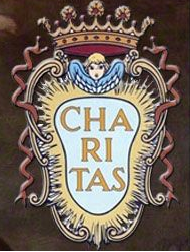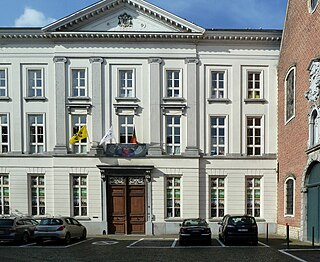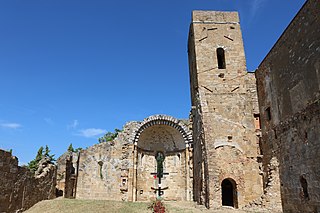
A monastery is a building or complex of buildings comprising the domestic quarters and workplaces of monastics, monks or nuns, whether living in communities or alone (hermits). A monastery generally includes a place reserved for prayer which may be a chapel, church, or temple, and may also serve as an oratory, or in the case of communities anything from a single building housing only one senior and two or three junior monks or nuns, to vast complexes and estates housing tens or hundreds. A monastery complex typically comprises a number of buildings which include a church, dormitory, cloister, refectory, library, balneary and infirmary, and outlying granges. Depending on the location, the monastic order and the occupation of its inhabitants, the complex may also include a wide range of buildings that facilitate self-sufficiency and service to the community. These may include a hospice, a school, and a range of agricultural and manufacturing buildings such as a barn, a forge, or a brewery.

The dissolution of the monasteries, occasionally referred to as the suppression of the monasteries, was the set of administrative and legal processes between 1536 and 1541, by which Henry VIII disbanded monasteries, priories, convents, and friaries in England, Wales, and Ireland; expropriated their income; disposed of their assets; and provided for their former personnel and functions.

The Order of Friars Minor Capuchin is a religious order of Franciscan friars within the Catholic Church, one of three "First Orders" that reformed from the Franciscan Friars Minor Observant, the other being the Conventuals (OFMConv). Franciscans reformed as Capuchins in 1525 with the purpose of regaining the original Habit (Tunic) of St. Francis of Assisi and also for returning to a stricter observance of the rule established by Francis of Assisi in 1209.

The Poor Clares, officially the Order of Saint Clare, originally referred to as the Order of Poor Ladies, and also known as the Clarisses or Clarissines, the Minoresses, the Franciscan Clarist Order, and the Second Order of Saint Francis, are members of a contemplative Order of nuns in the Catholic Church. The Poor Clares were the second Franciscan branch of the order to be established. Founded by Clare of Assisi and Francis of Assisi on Palm Sunday in the year 1212, they were organized after the Order of Friars Minor, and before the Third Order of Saint Francis for the laity. As of 2011, there were over 20,000 Poor Clare nuns in over 75 countries throughout the world. They follow several different observances and are organized into federations.

The Minims, officially known as the Order of Minims, and known in German-speaking countries as the Paulaner Order, are a Roman Catholic religious order of friars founded by Francis of Paola in fifteenth-century Italy. The order soon spread to France, Germany and Spain, and continues to exist today.

Francis of Paola, O.M., was an Italian mendicant friar and the founder of the Roman Catholic Order of Minims. Unlike the majority of founders of men's religious orders, and like his patron saint, Francis was never ordained a priest.

The Monastery of Santo Toribio de Liébana is a Roman Catholic monastery located in the district of Liébana, near Potes in Cantabria, Spain. Located in the Cantabrian Mountains in northern Spain, the monastery is one of the five places in Roman Catholicism, together with Rome, Jerusalem, Santiago de Compostela and Caravaca de la Cruz, that has the privilege of issuing perpetual indulgences.

The Roman Catholic Diocese of Grenoble–Vienne-les-Allobroges is a diocese of the Latin Church of the Roman Catholic Church in south-eastern France. The diocese, erected in the 4th century as the Diocese of Grenoble, comprises the department of Isère and the former canton of Villeurbanne (Rhône), in the Region of Rhône-Alpes. In 2006, the name was changed from the diocese of Grenoble to the diocese of Grenoble–Vienne. The current bishop is Jean-Marc Eychenne, appointed on September 14, 2022.
The Third Order Regular of St. Francis of Penance or simply the Third Order Regular of St. Francis is a mendicant order rooted in the Third Order of St. Francis which was founded in 1221. The members add the nominal letters T.O.R. after their names to indicate their membership in the congregation.
The Capuchin Friary in Crest in Drôme, France, is a Capuchin convent.

The Dominican Priory, Viborg, or Blackfriars (Sortebrødrekloster) was an important Dominican monastery in Viborg, Denmark, during the Middle Ages.

The Armenian Patriarchate of Jerusalem, also known as the Armenian Patriarchate of Saint James, is located in the Armenian Quarter of Jerusalem. The Armenian Apostolic Church is officially recognised under Israel's confessional system, for the self-regulation of status issues, such as marriage and divorce.
The suppression of monasteries refers to various events at different times and places when monastic foundations were abolished and their possessions were appropriated by the state.

The Monastery of Santa Maria de Maceira Dão is a monastery in the civil parish of Fornos de Maceira Dão, in the municipality of Mangualde in the Portuguese central subregion of Dão-Lafões, classifies as National Monuments.

The Monastère de Chalais, also called Châlais-sur-Voreppe or Notre-Dame de Châlais, is a Dominican convent near the town of Voreppe, Isère, France. The convent dates from 1101. The monastery at Chalais began as a house of male hermits, under the guidance of S Hugh of Chateauneuf, like the Carthusian monks. At first the Order of Chalais was independent, but in 1303 it was absorbed by the Carthusians. The monastery was partly destroyed in 1562 during French Wars of Religion, but was rebuilt. The state seized it during the French Revolution (1789–99) and sold it to a private owner. From 1844 to 1887 it was again a monastery, this time of the Dominican friars, before again being sold. The present community of Dominican nuns bought the property in 1963 and restored it. Today the nuns of Chalais manufacture Monastic biscuits to cover their expenses.

The church dedicated to saint Francis of Assisi, known for centuries as San Francesco Grande is a religious building on the Via San Francesco, previously overlooks the Contra porteghi high in Padua, Italy. Through the efforts of Baldo de Bonafarii and Sibilla de Cetto, the convent of the Friars Minor and the Hospital of Saint Francis, Major, operated until 1798.

The Abbey of Saint Pons is one of the oldest monasteries on the French Riviera, along with Lérins Abbey. It is located in the municipality of Nice in the Alpes-Maritimes. The original abbey was constructed between 774 and 800 and entrusted to the Benedictines. However, in 890, it was destroyed by the Saracens during a failed attack on Nice. The church was rebuilt in 1724 in Baroque style.

St. Joseph Minor Seminary is a Catholic secondary school in Sint-Niklaas, Diocese of Ghent, Belgium. There were previously a Recollect monastery and a seminary on the site.

The Abbey of the Holy Savior and of Sts. Justin and Clement, also known as the Camaldolese Abbey of St. Justin, is a former Italian monastery in the city of Volterra, Pisa, which was founded in the 11th century. It was a major religious institution of the region until it was initially abandoned by the monks due to earthquake damage in the 19th century and then taken over and dissolved under the Risorgimento movement for the political unification of the Italian peninsula. For most of its history, it operated as a monastery of Camaldolese monks.

Holy Family Church is a parish church of the Roman Catholic Diocese of Columbus, in the Franklinton neighborhood of Columbus, Ohio. The congregation was founded in 1877 and the current church was completed in 1889. The Mercerdarians took over pastoral care of the church in 2022.


















